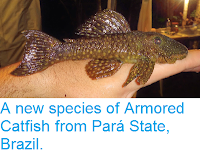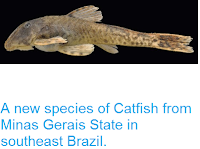Catfish, Siluriformes, are the most abundant group of freshwater Fish, comprising rougly 22% of all Fish found in non-marine waters. While most Catfish groups are exclusively found in freshwater ecosystems, two groups, the Ariidae and Plotosidae, are found in marine waters. The Plotosidae are Eel-like Catfish found in the Indo-Pacific Region, which lack a fossil record, while the Ariidae, are found on continental shelves, brackish waters, and some freshwater ecosystems in tropical regions around the Atlantic, Indian and Pacific Oceans. The Ariidae first appear in the fossil record in the Cretaceous of North America, reaching Europe in the Palaeocene and Africa and Asia in the Eocene. The Eocene fossil record of the Ariidae in Afrca comprises fragmentary material from Nigeria, Libya and Egypt, but to date no intact specimens.
In a paper published in the journal PLoS One on 1 March 2017, Sanaa El-Sayed, Mahmoud Kora and Hesham Sallam of the Vertebrate Paleontology Center at Mansoura University, Kerin Claeson of the Department of Anatomy at the Philadelphia College of Osteopathic Medicine, Erik Seiffert of the Department of Cell and Neurobiology at the University of Southern California, and Mohammed Antar of the Department of Geology and Paleontology at the Egyptian Environmental Affairs Agency, describe a new species of Ariid Catfish from the Qarun Formation of the the Wadi El-Hitan (Valley of the Whales) site of the Fayum Depression of northern Egypt.
The Wadi El-Hitan location is noted for the production of numerous intact Vertebrate fossils, notably Whales (hence the name) from a shallow marine environment. It is home to the earliest known fully marine Whales, but has also produced a variety of other fossils, including Crocodiles, Sirenians and Fish. The site was made a UNESCO World Heritage Site in 2005.
The new species is named Qarmoutus hitanensis, where 'Qarmoutus' derives from the Arabic word for Catfish and 'hitanensis' means 'from Hitan'. The species is described from a series of disarticulated elements presumed to have come from a single individual, namely a nearly complete neurocranium, a partial right dentary, a pair of opercles, a left suspensorium, a left pectoral girdle (cleithrum articulated with pectoral spine), the first and second dorsal spines, two paired nuchal plates, the Weberian apparatus and three disarticulated abdominal vertebrae. These are estimated to be about 37 million years old, and can be confidently assigned to the Ariidae due to their distinctive surface sculpture.
Dorsal view of the left neurocranium and nuchal plates of Qarmoutus hitanensis. (A) Photograph and (B) Line drawing. Anatomical abbreviations: afo, anterior cranial fontanelle; anp, anterior nuchal plate; ar.pstt, articulation facet for posttempro-supracleithrum; ext, extrascapular; fn, fenestra; fopth, foramen for ophthalmic nerve; fr, frontal; le, lateral ethmoid; le.lh, lateral ethmoid lateral horn; me, mesethmoid; mg, medial groove of the neurocranium; pnp, posterior nuchal plate; prp4, parapophysis of the fourth vertebra; pt, pterotic; sc, symplectic canal; sp, sphenotic; suoc, parieto-supraoccipital; suoc. pr, parieto-supraoccipital process; W.cc, Weberian compound cenrum; 1st ptg, first pterygiophore. El-Sayed et al. (2017).
See also...
Follow Sciency Thoughts on Facebook.







